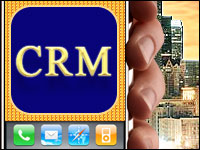
When Mobile CRM Goes Too Far, Part 1When Mobile CRM Goes Too Far, Part 2
Mobile everything is the current computing zeitgeist and if that means turning an app or function that is perfectly suited for desktop use into a mobilized one, well, as the thinking goes at so many companies now, just do it.
However, mobilizing an app — even a front-office CRM app — should not be undertaken lightly. There are the costs, for starters, and then there are the new security vulnerabilities that going mobile opens up. Also, believe it or not, customers do not necessarily want every online function available to them in a mobile format.
If mobilizing everything is a bad idea, then mobilizing only the bare essentials may be a worse one. It is certainly not a stance that will endear you to your mobile-happy customers and employees.
When You’ve Got to Have It
Mobile CRM is disruptive, without a doubt. To shun it or even to stint on it would quickly become the kind of competitive differentiator you wouldn’t want to claim.
Consider just a few use cases where mobile has become essential, for example.
“Your staff are often working on the road, from home, on the go — so having the flexibility of being able to check in to customer feeds becomes more critical to efficient business practice,” said Syed Hasan, CEO of ResponseTek.
Mobile is now essential for those in field services roles, such as home technicians and area managers, who are constantly traveling, he told CRM Buyer.
“Mobile is becoming the only possible way to communicate customer information in a timely basis,” Hasan said.
A Few Tips
Focus on the difference the mobile experience can offer a user from the desktop, advised Nara Balakrishna, VP of marketing and strategy at Appirio.
“Trying to re-create or provide all the same functionality is a counterproductive strategy,” she told CRM Buyer. “When a salesperson, manager or field service person is on a mobile device, they are not trying to do what they would at a desktop.”
Some of the actions a field salesperson might carry out with a mobile app, for example, include collaborating on a task, asking a question of someone in the office, sharing a file, or recording a follow-up action or activity.
“Providing this salesperson with a mobile experience that centers around those actions in context is the key to success,” said Balakrishna.
Also, think about how people really use their smartphones during the work day, said Mike Topalovich, CTO of Delivered Innovation.
For simplicity’s sake, particularly in a B2B scenario, offer “just enough functionality to where data can be captured and information can be found and read on a 20-floor elevator ride, a cross-town cab ride, or in the precious minutes between taking your seat on a flight and being asked to turn off electronic devices,” he told CRM Buyer.
It’s also a good idea to learn how end users really do use devices and mobile apps, Bluewolf CMO Corinne Sklar suggested.
“Instead of making assumptions about what is needed by the users, spend time on the front lines with them,” she told CRM Buyer. “This investment of time will tell you where your users’ pain points lie and how workflow efficiencies can be gained.”
Going Mobile With Consumers
Equipping road warriors with the tools they require may be a no-brainer, but when it comes to consumer-oriented apps, to mobilize or not to mobilize can be a tough question.
Brands have to keep in their sights what value — if any — a mobile app will add to the consumer, said Kayla Green, digital strategy director at Saatchi & Saatchi LA.
There comes a point with all personalized or broad-based messaging when it is no longer is useful. Unless it is planned with a consumer-first approach, it just turns into noise, she told CRM Buyer.
“The potential for CRM-based mobile apps to do this is high, especially when a brand is not respectful of a consumers’ personal time and space,” said Green.
For example, “geolocating a consumer and sending them a generic push notification every time they walk through a store might not be respectful, nor is it personal,” she noted.
“Instead, ask your consumers to opt-in for special alerts based on their own personal preferences,” she suggested, “and send them messages that are relevant and tailored to the context.”
























































